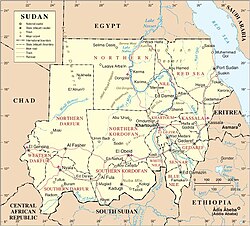Wadi Howar
| Wadi Howar | |
|---|---|
 Map of Sudan (after 2011) | |
| Physical characteristics | |
| Mouth | Nile |
• coordinates | 18°11′56″N 30°44′26″E / 18.19889°N 30.74056°E |
Wadi Howar (Wadi Howa or Yellow Nile) is a wadi in Sudan and Chad.
Geography
Originating in the
Northern to join the Nile north of the great bend opposite Old Dongola. Stretching over 1100 km[1]: 25 in west–east direction across the southern fringes of the Libyan Desert, it ordinarily receives 25 mm of rainfall per year.[2]
Holocene period

Wadi Howar is the remnant of the ancient
Neolithic Subpluvial from about 9500 to 4500 years ago. At that time Savanna fauna and cattle-herders occupied this region and the southern edge of the Sahara was some 500 km further north than it is today.[2] When the Sahara underwent desertification between 6000 and 4000 years ago, the wadi first became a chain of freshwater lakes and marshes, as shown by Ptolemy's world map, then it became extinct about 2000 years ago.[1]
: 28
Archaeology
Abundant prehistoric sites certify Wadi Howar as a once ecologically favoured area of settlement and a communication route between the inner regions of Africa and the Nile Valley.[1]: 31 The hitherto most thoroughly investigated archaeological site in the wadi is Gala Abu Ahmed.
See also
References
- ^ ISBN 978-9970-25-005-9.)
{{cite book}}: CS1 maint: location missing publisher (link - ^ S2CID 3894313.
